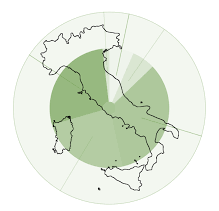Patients with type 2 diabetes mellitus (T2DM) are rapidly increasing in Italy due to aging, preventable risk factors, and a worsening socioeconomic environment. T2DM and its consequences take a heavy toll on health care systems and the economy, given the costly management, difficulties in coping with daily life, and decreased productivity of patients/workers. Considering the long life expectancy in Italy and a decreasing mortality rate due to T2DM, this study aims to calculate the years lived with disability (YLD) of T2DM and its sequelae grouped into three categories: Neuropathy, Chronic Kidney Disease and No Complications, taking into consideration gender, year and geographical location. This is the first attempt to measure years lived with disability (YLD) from data that are not based on self-reported diabetes diagnoses. The data come from the Italian Diabetes Association dataset, the most comprehensive longitudinal source of national outpatient data. YLDs are obtained by multiplying the number of individuals living with a specific health condition by a Disability Weight that represents the amount of health loss associated with that particular condition. The results show an increase in age-standardized rates of YLD for T2DM and its sequelae, particularly neuropathy, with a stronger trend in the central macroregion and among men, and that 2009 marks a structural change in the growth rate of YLD. Systematic collection of data to measure the burden of disease is critical for policy making and implementation, among other things.
- Abbafati C, Nieddu L, Monasta L. Measures of type 2 diabetes burden in Italy assessed using the AMD dataset over a twelve-year span across the Great Recession. Sci Rep. 2024 Feb 28;14(1):4901. https://doi.org/10.1038/s41598-024-54989-8
